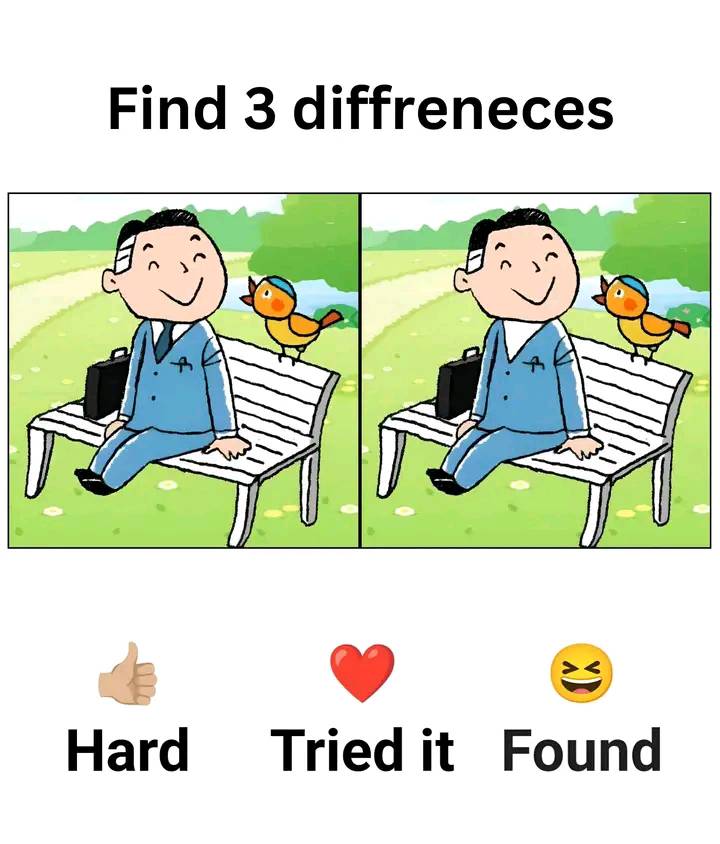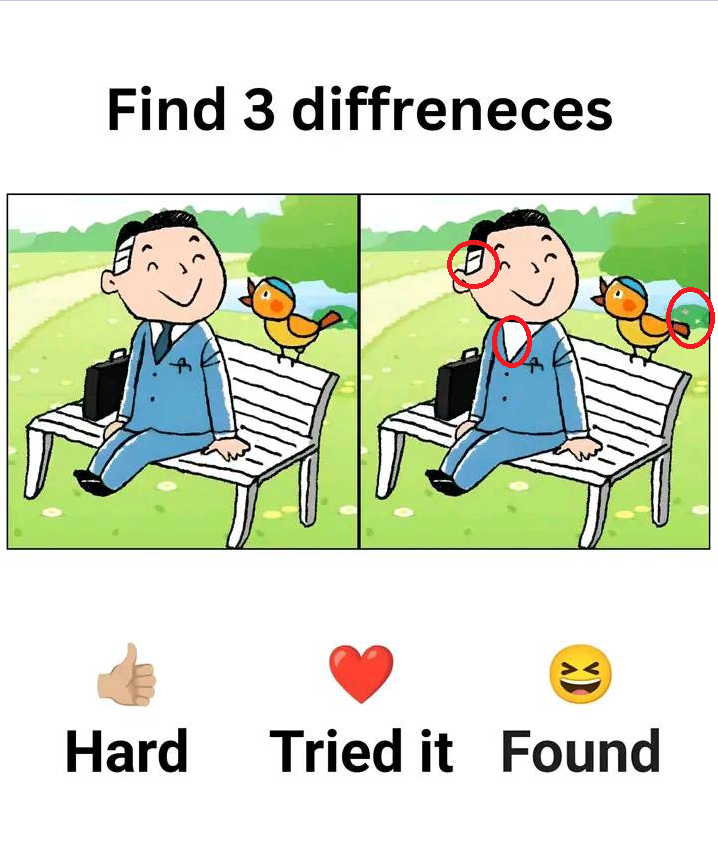Visual puzzles like “Find the Difference” are more than just a fun distraction—they’re actually a fantastic way to give your brain a workout. They help train your focus, sharpen your ability to notice small details, and improve your visual memory. Today’s challenge invites you to study two side-by-side images of a man sitting on a bench with a small orange bird perched beside him.

At first glance, the two pictures look exactly the same, but hidden within are three subtle differences that can easily go unnoticed unless you’re truly paying attention. Your mission? Find all three changes before scrolling to the answers. What makes spot-the-difference puzzles so enjoyable is how they force your brain to slow down and examine each element of the scene carefully, a rare task in today’s fast-paced, constantly-scrolling world. These puzzles train your eyes and your mind to work together, improving cognitive skills and giving you a little dose of satisfaction every time you catch a hidden detail.
The joy of spotting something that others might miss gives your brain a rush of dopamine—that little jolt of reward that makes these games so addictive. But don’t assume you’ll breeze through it. These puzzles are carefully designed to trip you up. Our brains naturally crave balance and symmetry, so they often overlook small changes. Most people instinctively focus on the largest or brightest parts of an image—faces, bold colors, or main subjects—while the changes are cleverly hidden in more subtle spots. That’s the trick: the smallest tweaks are the ones that take the longest to spot. Now let’s break down this particular puzzle.
First, look closely at the man’s suit jacket. In the left image, there’s a crisp white pocket square sticking out of his front pocket. But if you check the right image, it’s mysteriously gone. It’s such a minor change that it’s easy to overlook, but once you catch it, it’s impossible to unsee. Next, turn your attention to the man’s tie. In the left photo, it’s long and narrow, hanging straight and looking neat. In the right image, the tie appears wider and shorter, almost as if it’s been styled differently. The color remains the same in both pictures, which makes it even trickier for your eyes to register the difference.
This is a classic illusion technique where subtle shape changes can confuse the brain if other elements, like color, stay consistent. Finally, examine the small orange bird sitting beside him. In the left image, the bird has both wings visible—one neatly folded and the other slightly lifted. But in the right photo, the wing facing us has disappeared completely. Because we tend to mentally “fill in” what we expect to see, your brain might assume the wing is still there unless you’re looking really closely. So, to recap the three differences: the man’s pocket square vanishes, the shape of his tie changes, and one of the bird’s wings is missing. Simple, right? Maybe not. Many people miss at least one on their first try. That’s what makes these puzzles so beneficial—not just fun, but helpful in developing mental sharpness and attention to detail. These brain teasers strengthen your short-term memory by forcing you to compare patterns visually, and they help you develop problem-solving skills without even realizing it. Want to turn it into a fun activity? Challenge your friends or family to find the differences without giving away the answers. See who can do it the fastest or who spots the trickiest change first. Ask them which detail stumped them and how long it took to catch them all.

It’s a great way to bond, compete in a low-stress way, and get everyone’s brain cells firing. The more you practice with puzzles like this, the better you’ll get at noticing small inconsistencies—not just in images, but in real life. Whether it’s catching an error in a document or noticing when something’s out of place in your environment, these skills carry over into everyday awareness. So the next time you see a “spot the difference” image, don’t scroll past. Dive in and see how sharp your eyes really are. Keep testing yourself, and you might be surprised at just how observant you can become.





